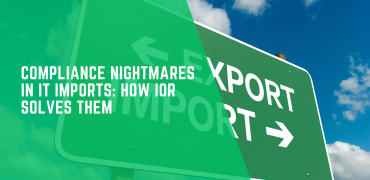Navigating the complexities of international trade is challenging, particularly for IT and telecom companies looking to expand their operations into Ecuador. One critical aspect of this process is understanding the Importer of Record (IOR) service, which is essential for compliance with Ecuadorian import regulations. This guide provides comprehensive insights into the IOR service, the import duties and taxes applicable to IT and telecom equipment, and the special permits and approvals required.
What is an Importer of Record (IOR)?
An Importer of Record is a legal entity or individual responsible for ensuring that imported goods comply with local laws and regulations. The IOR handles various tasks, including:
- Ensuring proper documentation and labeling.
- Paying applicable duties, taxes, and fees.
- Meeting compliance requirements.
- Facilitating customs clearance.
For IT and telecom companies, partnering with a reliable IOR service in Ecuador can streamline the import process, mitigate risks, and ensure regulatory compliance.
Importance of IOR Services for IT and Telecom Companies
The technology and telecommunications sectors are highly regulated, with stringent import requirements. Utilizing an IOR service provides several benefits:
- Compliance with Regulations: IOR services ensure adherence to local import laws, reducing the risk of penalties and delays.
- Efficient Customs Clearance: Experienced IOR providers facilitate smoother customs procedures, minimizing the time and effort required for importation.
- Risk Mitigation: By handling all legal and regulatory responsibilities, IOR services protect companies from potential legal issues.
- Cost Management: IOR services can help predict and manage import costs, including duties and taxes, ensuring better financial planning.
Import Duties and Taxes on IT and Telecom Equipment in Ecuador
When importing IT and telecom equipment into Ecuador, companies must be aware of the various duties and taxes imposed by the government. These charges can significantly impact the overall cost of imported goods. The main duties and taxes include:
1. Customs Duties (Aranceles Aduaneros)
Customs duties are levied on imported goods based on their classification in the Harmonized System (HS) code. The rate varies depending on the type of equipment:
- Computers and Peripheral Equipment: Typically subject to duties ranging from 0% to 15%.
- Telecommunication Devices: Duties generally range from 5% to 20%.
- Networking Equipment: Usually falls within the 10% to 20% duty range.
2. Value-Added Tax (VAT)
Ecuador imposes a standard VAT of 12% on most imported goods, including IT and telecom equipment. This tax is calculated based on the CIF (Cost, Insurance, and Freight) value plus customs duties.
3. Special Consumption Tax (ICE)
Some telecom products, particularly luxury items or specific high-end devices, may be subject to the Special Consumption Tax (ICE). The rates for ICE vary widely, depending on the product category.
4. Additional Taxes
There are occasional additional taxes or fees imposed on specific goods or during certain periods. It’s essential to stay updated on any temporary or supplementary taxes that may apply.
Special Permits and Approvals Needed
Importing IT and telecom equipment into Ecuador requires more than just handling duties and taxes. Special permits and approvals are often necessary to comply with local regulations. Here are the key permits and approvals required:
1. Telecommunication Regulatory Agency Approval (ARCOTEL)
The Agency for Regulation and Control of Telecommunications (ARCOTEL) oversees the import and use of telecom equipment in Ecuador. Key requirements include:
- Type Approval: Ensures that the equipment meets Ecuadorian standards and can operate within the country’s telecommunication infrastructure.
- Import Licenses: Specific licenses may be required for certain types of equipment, particularly those involving radio frequencies.
2. Ministry of Industry and Productivity (MIPRO) Certification
MIPRO regulates the importation of electronic and IT equipment to ensure compliance with safety and environmental standards. Certifications from MIPRO might include:
- Quality and Safety Standards: Certification that the imported equipment meets local quality and safety regulations.
- Environmental Compliance: Ensures that the products adhere to environmental protection guidelines.
3. National Customs Service of Ecuador (SENAE)
SENAE handles the customs processes and may require specific documentation and approvals for importing IT and telecom equipment, including:
- Commercial Invoice: Detailed listing of the goods being imported.
- Bill of Lading: A document issued by the carrier to acknowledge receipt of the cargo.
- Packing List: A detailed inventory of the goods in the shipment.
- Certificate of Origin: To determine the country of manufacture of the goods, which may affect duty rates.
4. Additional Certifications and Permits
Depending on the type of equipment, additional permits might be necessary, such as:
- Frequency Allocation Permits: For devices that use specific radio frequencies.
- Health and Safety Certifications: For equipment that may impact public health or safety.
Steps to Engage an IOR Service for IT and Telecom Equipment in Ecuador
Engaging an IOR service can simplify the import process and ensure compliance with all regulatory requirements. Here are the steps to follow:
1. Identify a Reliable IOR Service Provider
Look for a provider with expertise in IT and telecom equipment, and a proven track record in Ecuador. Key considerations include:
- Experience: Years of operation and familiarity with Ecuadorian regulations.
- Reputation: Reviews and references from other clients in the industry.
- Range of Services: Comprehensive offerings, from documentation to customs clearance.
2. Provide Detailed Information About the Equipment
Supply the IOR service with detailed information about the equipment to be imported, including:
- Technical Specifications: Detailed descriptions and HS codes.
- Compliance Certificates: Any existing certifications or approvals from other countries.
- Intended Use: Information on how and where the equipment will be used in Ecuador.
3. Prepare Necessary Documentation
Ensure that all required documents are prepared and submitted to the IOR service. This may include:
- Commercial Invoices: Detailed billing information.
- Bills of Lading: Transportation documents.
- Certificates of Origin: Proof of manufacturing origin.
- Technical Documentation: Manuals and safety information.
4. Coordinate with Regulatory Agencies
The IOR service will coordinate with ARCOTEL, MIPRO, SENAE, and other relevant agencies to obtain necessary permits and approvals. Ensure ongoing communication with the IOR provider to address any issues or additional requirements promptly.
5. Monitor the Import Process
Stay in touch with the IOR service throughout the import process to monitor progress and ensure timely customs clearance. Address any issues or delays immediately to avoid additional costs or penalties.
Conclusion
Importing IT and telecom equipment into Ecuador involves navigating a complex regulatory landscape, including various duties, taxes, and permits. Utilizing an Importer of Record (IOR) service can significantly streamline this process, ensuring compliance and efficient customs clearance.
For IT and telecom companies looking to expand into the Ecuadorian market, understanding the import duties, taxes, and special permits required is crucial. By partnering with a reliable IOR service provider, companies can mitigate risks, manage costs, and focus on their core business operations, confident in the knowledge that their import activities are fully compliant with Ecuadorian regulations.




